by Adela Lovric // Mar. 7, 2025
In an ambitious effort to set the historical record straight, a sprawling group exhibition at Kunsthalle Bega in Timișoara primarily examines Romanian colonial projects and tendencies. Titled ‘Land of Fire,’ the show references Tierra del Fuego—an archipelago at the southern tip of South America, now part of Chile—where Bucharest-born Iuliu Popper left behind a notorious legacy of violence, as one of the most powerful conquerors and settlers of the late 19th century.
To this sorely unacknowledged chapter of Romanian history also belongs the fact that Popper was a major perpetrator of the genocide against the Selk’nam people—a crime formally recognized by the Chilean Congress only last year. Among many other history lessons, the exhibition also highlights Romanians’ involvement in scientific expeditions, which played a key role in European colonialism, to places such as Papua New Guinea, Somalia and Ethiopia.
This alone provides ample material to explore artistically and curatorially. However, the exhibition curator Cosmin Costinaș, alongside co-curators Mona Vătămanu and Florin Tudor, takes a more investigative approach, incorporating later Romanian colonial projects in Cadrilater (South Dobruja), Bulgaria, as well as the occupation of Transnistria (a separatist enclave in Moldova) and the genocide of Jews and Roma between 1941 and 1944, among other references.
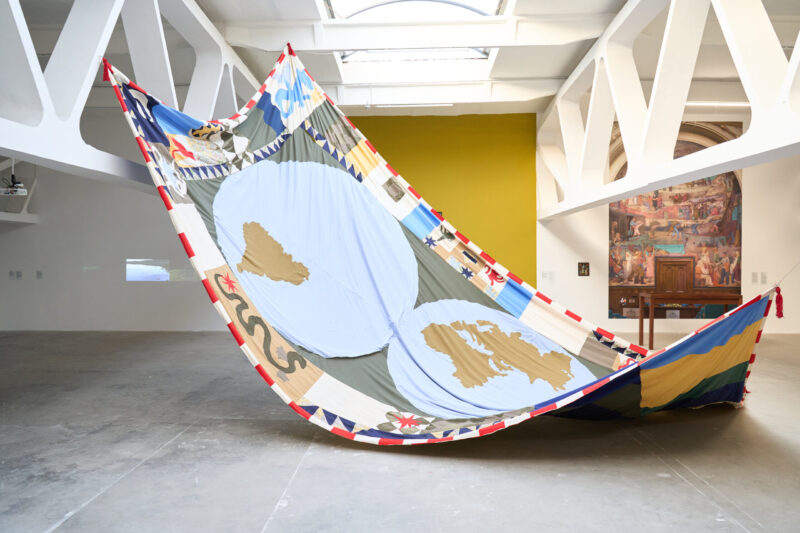
Loredana Ilie: ‘Hic Svnt Dracones,’ 2024, Production by Kunsthalle Bega // Photo by Vlad Cîndea
As the exhibition texts suggest, this overlooked history is not at odds with Romania’s self-mythologizing as “a nation of mostly inward-looking peasants, who tended to identify more with Indigenous peoples and constructed for themselves a history centered on resisting imperial oppression.” Rather, it is integral to understanding the ideologies that shaped the genocides of the 20th century. The exhibition thus seeks to illuminate the visual languages that construct Romania’s self-image, as well as the narratives that have been excluded from dominant historical accounts.
Recalling Haile Selassie’s 1936 speech at the League of Nations in Geneva—now remembered as a manifesto of anti-colonial resistance—and Romanian diplomat Nicolae Titulescu’s impassioned cry, “À la porte, les sauvages!” (“Out with the barbarians!”) against the Italian fascist journalists heckling the Ethiopian emperor, the exhibition also explores the enduring dichotomy of civilization versus barbarism. While this binary lies at the core of colonialism, it also underpins processes of self-colonization—an internal form of othering that replicates the colonial logic within its own borders.
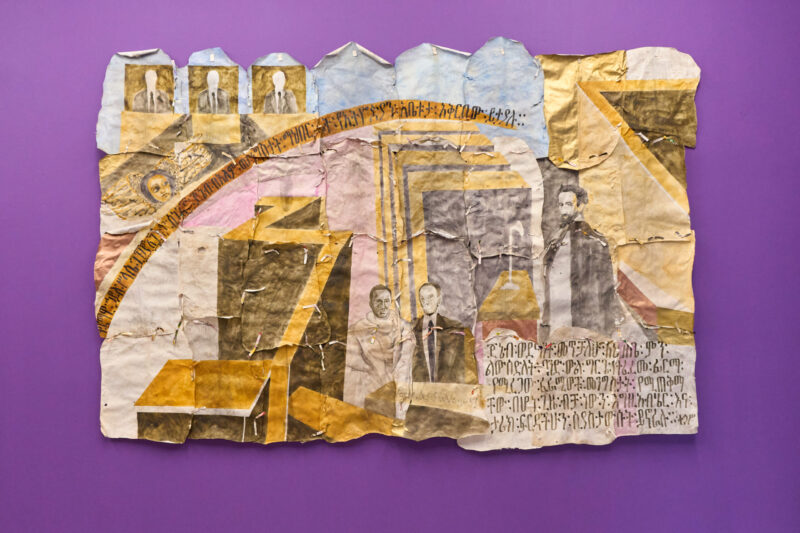
Robel Temesgen: ‘Unorthodoxy Unfolding: A Mural of Defiance,’ 2024 // Photo by Vlad Cîndea
Robel Temesgen’s ‘Unorthodoxy Unfolding: A Mural of Defiance’ (2024) responds to the iconic mural by Agegnehu Engida, commissioned by Selassie to commemorate the pivotal moment when the narrative of barbarism was turned back against the fascists. On a three-by-four-meter patchwork of goat-skin parchment, Temesgen used acrylic, ink and pencil to recreate the scene from the League of Nations, evoking the spirit of courage and the triumph of higher principles over silence and conformity. The work calls to mind those who have recently spoken up for Palestinian human rights in spaces where their dehumanization continues with violent persistence. One of the first artworks visitors encounter, it is also one of the most powerful—positioning colonialism and fascism, both past and present, as the greatest and most barbaric threat.
Mona Vătmanu and Florin Tudor’s film ‘They All Became Birds’ (2024) is one of several featured works addressing Romania’s colonial past in Tierra del Fuego head on, namely Popper’s role in the violence against Indigenous communities and, in particular, the genocide of the Selk’nam people. The film is a poetic exploration of archival material, which draws out a larger pattern of Romanian self-colonization and its framing of own territorial ambitions as mere geographical exploration.
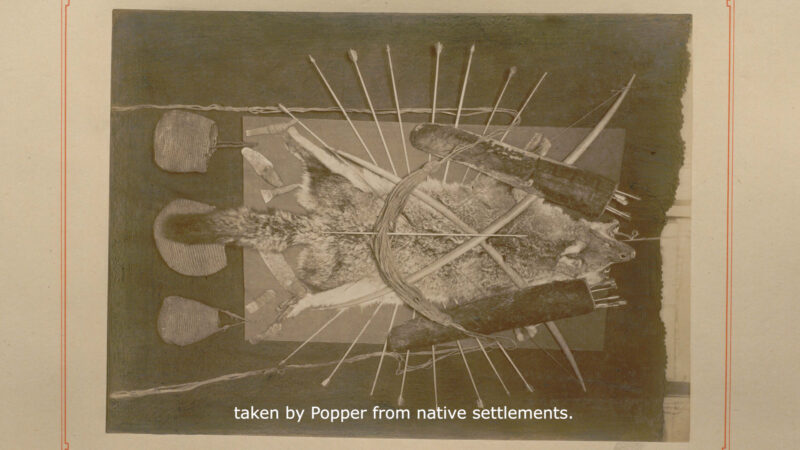
Mona Vătămanu and Florin Tudor: ‘They All Became Birds,’ 2024, film still // Courtesy of the artists and Kunsthalle Bega
One of the most harrowing chapters of local history, the Holocaust in Romania is confronted in Ștefan Sava’s photographic series ‘Atoms and Void, Landscapes’ (2009-2010). The work captures present-day landscapes of sites where the Dorohoi Pogrom, Bucharest Pogrom, Iași Pogrom and the so-called death trains, took place. Visually mundane, these images serve as a stark reminder of how easily—and deliberately—tragedies of this magnitude fade from collective memory.
Alexandra Gulea’s short film ‘Valea Jiului – notes’ (2018) reflects on the turbulent history of mining in Romania and what was left in the aftermath of the closure of the majority of mines. Showing a once busy industrial place, now a ghost town abandoned by the state and depopulated, the film draws attention to the children left behind by their parents who emigrated out of the country in search for work opportunities. While taken care of financially from abroad, these “white orphans” often sink into depression, primarily due to separation from their mother, which, in the most severe cases, ends in suicide.
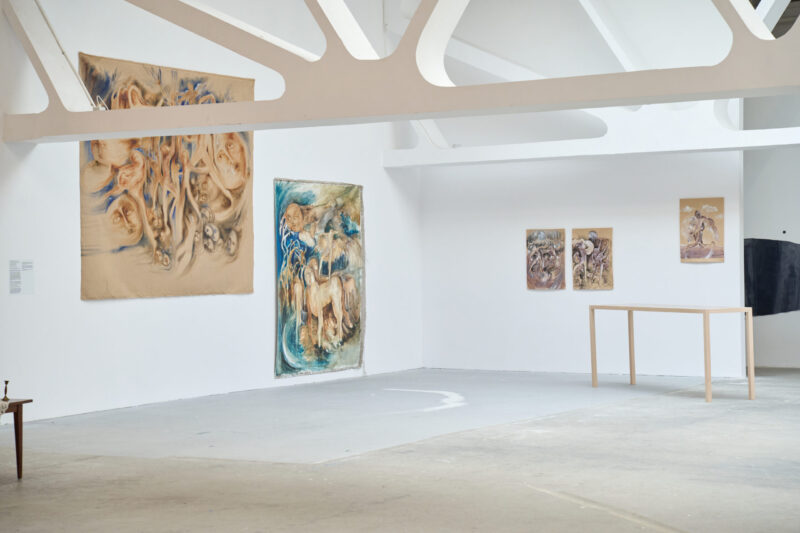
Sana Shahmuradova Tanska, installation view, Kunsthalle Bega, 2024 // Photo by Vlad Cîndea
While brilliantly surfacing a tangle of lesser-known histories and tracing colonial continuities across centuries and geographies, the show also presents a hodgepodge of artistic positions—fascinating yet difficult to integrate cohesively within the format of an exhibition. Some are more immediately graspable than others, such as Sana Shahmuradova Tanska’s haunting paintings of her native Ukraine. With this series of works, the artist depicts apparitions of fading cultural memory and trauma born of historical oppression, set against the backdrop of ongoing Russian aggression.
Although a personal favorite, Citra Sasmita’s ‘Timur Merah Project VII: Divine Comedy’ (2021–2022)—a six-meter-long Kamasan-style painting referencing the Javanese migration to Bali after the fall of the Hindu Majapahit kingdom—is one of the works that feels less immediately connected to the exhibition’s overarching narrative. Another example is Sakarin Krue-On’s series of miniature reproductions of traditional Thai mural paintings from Buddhist temples in Bangkok, which, while remarkable in their own right, seem even further removed from the show’s common threads.
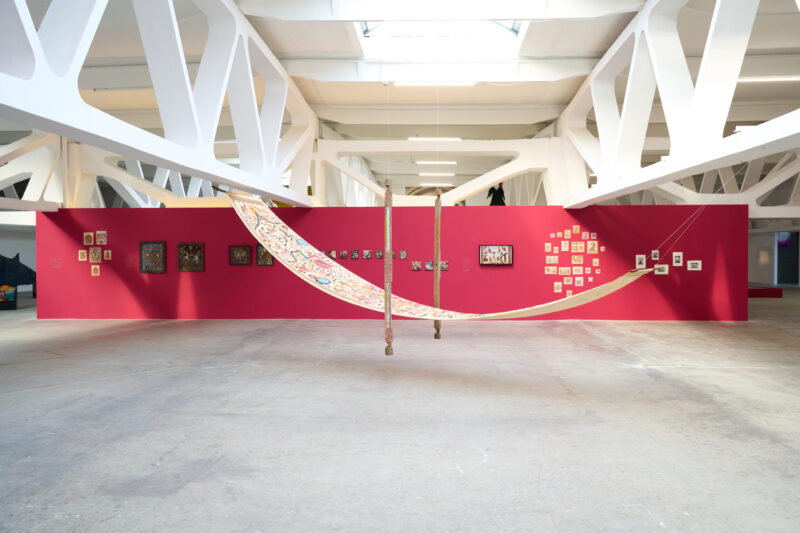
‘Land of Fire,’ installation view, curated by Cosmin Costinaș, co-curated by Mona Vătămanu and Florin Tudor, Kunsthalle Bega // Photo by Vlad Cîndea
Presenting such a dense constellation of artworks—some of which feel thematically out of place—runs the risk of diluting their individual impact, as well as leaving curatorial intentions partly unacknowledged or misunderstood. Nevertheless, the exhibition remains a treasure trove of information and sincere artistic reflection, demanding heightened attention and striking the right emotional chord at a time when fascism and colonialism continue to rear their ugly heads.
Exhibition Info
Kunsthalle Bega
Group Show: ‘Land of Fire’
Exhibition: Oct. 18, 2024-Mar. 15, 2025
kunsthallebega.ro
Calea Circumvalațiunii 10, Timișoara 300254, Romania, click here for map



















